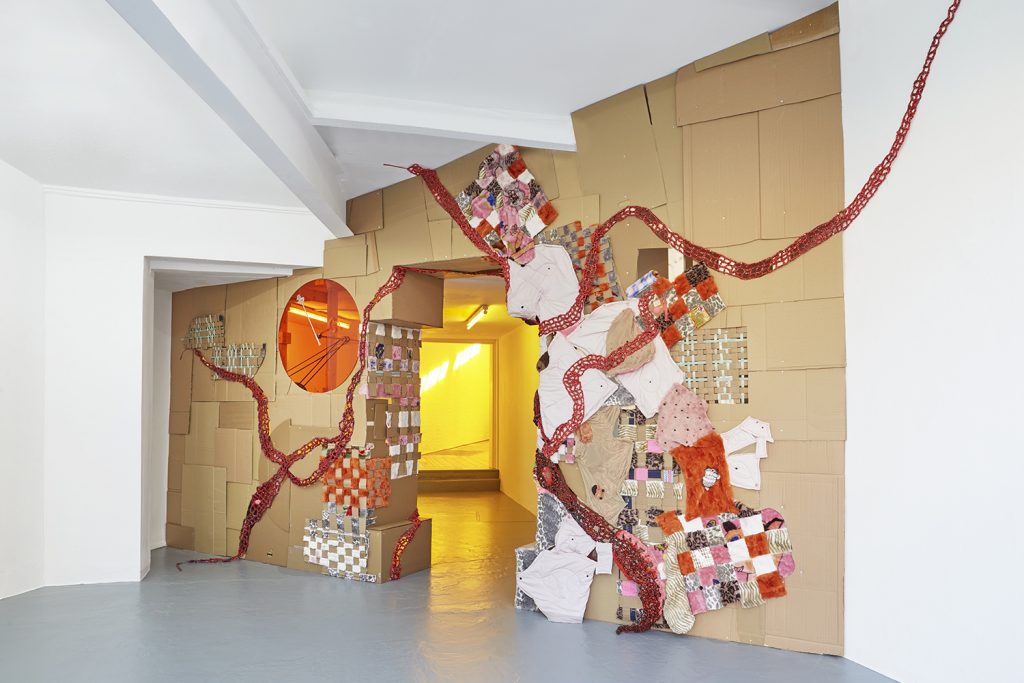In José Esteban Muñoz’s 1999 book Disidentifications: Queers of Colour and the Performance of Politics, the late theorist establishes how artists can transport both the performer and the spectator to a plane where transformation and politics are imaginable. This is achieved through what he refers to as disidentification: a process of simultaneously decomposing and re-composing cultural stereotypes in critical ways. Muñoz suggests that disidentifying with dominant ideology can become the basis for potential oppositional counterpublics. “Disidentification uses the majoritarian culture as raw material to make a new world”, he explains.

Tin Nguyen and Daniel Chew formed CFGNY (Concept Foreign Garments New York / Cute Fucking Gay New York) five years ago to explore what their website describes as “the intersection of fashion, race, identity, and sexuality”. With Kirsten Kilponen and Ten Izu joining in 2020, the New York-based collective produce clothes and installations which negate Western expectations of Asian aesthetics and identity. Their Collecting Dissonance exhibition—running May 21 to August 22 at London’s Auto Italia— purposefully draws upon Muñoz’s theorization of disidentification, and its world-making potentiality.
Upon entering the gallery is a partition composed of dissimilar materials with an open archway leading into the back. Swatches of fake fur and fleece printed with Pokémon characters are interlaced between layers of cardboard. Crocheted red plastic weaves across this composite wall, tentacle-like, interrupting the monochrome of the cardboard.On various patches of this façade, there is packaging from the anglophone potato chip brand Kettle woven into a gingham pattern with a bright baby blue trimming. This bricolage is the initial instance where CFGNY explore what it means to be ‘vaguely Asian’: a term used to refer to their disruption of hegemonic notions of ‘Asian-ness’. Easily consumable images of cuteness often attached to Western conflations and preconceptions of Asian cultures, such as Japanese kawaii, become obfuscated. There is a disidentification with the atypical descriptors of these ideals, namely charming, shy, or childlike. CFGNY do this in quite morbid ways, like taking apart a stuffed bear and attaching the toy’s fabric carcass to this wall but leaving its glistening eyes and nose still legible.
A circular cut of orange plexiglass, doubling as a clock face and an opening upon this large cardboard partition, creates intrigue for what lies beyond this boundary. On the reverse side is a kitsch mechanism powering the dial via a large vat of water slowly dripping into a secondary tank. Being a somewhat precarious system, it does not measure regular time. Through its fundamentally bootlegged form, CFGNY signal the need for alternative temporalities due to the collapse of various infrastructures under the strain of the pandemic. This additional entry way within the gallery acts as a sort of proposition to enter newly constructed worlds, its makeshift nature and unconventional materials giving the work a queer sensibility.

This feeling of entering another reality is enhanced by the fluorescent yellow lighting beyond the composite wall, distinguishing the interior from the gallery foyer that’s flooded with natural light. Within this other realm, larger-than-life images adorn the walls depicting each member of CFGNY modelling the collection produced in conjunction with the exhibition. Those garments are folded over two oddly-shaped, cardboard-faced chairs, or strewn on the floor nearby. The display highlights certain motifs upon the clothing: an oversized white bow, reminiscent of one you might find on the dress of an anime character, spills out from underneath one of the armchairs and is attached to the front of a marine blue puffer jacket. The juxtaposition of the aforementioned glossy fashion photography beside the physical pieces in a state of disarray, iterates the juxtaposition of dismantling and rebuilding existing majoritarian constructions. Yet, here they seem to invite those who enter this unearthly dressing room to disidentify with such subcultural aesthetics for themselves.
In previous projects there was a notable mistranslation between CFGNY and their tailors based in Vietnam. Patterns designed by the collective with cuts or joins associated with Eastern fashion norms, were edited by the Vietnamese manufacturers and Westernised on their own accord. CFGNY did not take issue with this. Rather, they saw it as a productive way to unfold the term ‘vaguely Asian’, as the clothes could no longer be traced back to a singular origin. Both the clothing and their installation within Auto Italia have no definitive place, gender, or identity either, instead staging an alternative world through Muñoz’s process of deconstructing and reconstructing the real.**
CFGNY’s exhibition Collecting Dissonance is on at London’s Auto Italia, running May 21 to August 22, 2021.













